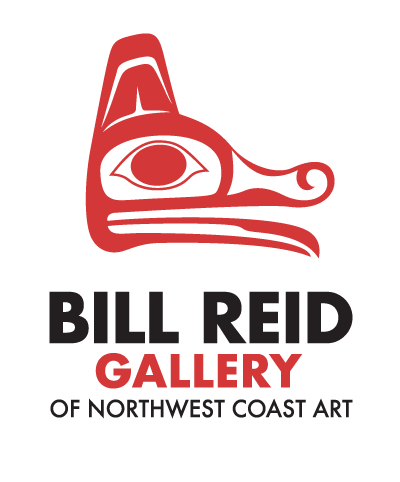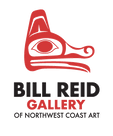As an emerging artist, curator, and a longtime art and Indigenous rights participant the act of learning is always on my mind. Learning about new works, concepts being re-explored, and materials being reworked is something that is exciting and inspiring. Considering how these ideas are considered is just as exciting as the act of learning because this awareness provides another way of understanding. This contextualization is important work because it informs an artwork while also being informed by the artwork. What I mean by this is that art and context work in tandem, they hold a conversation with one another.
During my time at the Bill Reid Gallery as the curatorial intern I have had an amazing opportunity to spend time with many works in the collection. I have also had the opportunity to spend time on the unceded territories of the xʷməθkwəy̓əm (Musqueam), Skwxwú7mesh (Squamish), and Səl̓ílwətaʔ/Selilwitulh (Tsleil-Waututh) peoples. This time spent with the land and the history is integral for a deeper understanding of the artworks at the gallery. I would like to mention here that Bill Reid is part of the Haida Nation and his work is an extension of Haida culture. Reid made many of his works in Vancouver and worked with people from various backgrounds. Most of the pieces I have been in contact with are extensions of the stories the land has shared with the people. These stories encapsulate knowledge about language, history, body, and considerably more.
This internship was made possible through Young Canada Works- Building Careers in Heritage program of Canadian Heritage. There was a lot of experiences to glean from during my time at the gallery but for the sake of focus I would like to share three contemporary Northwest Coast related artists, curators and exhibitions that I felt connected to.
__________________________
lessLIE
Cowichan, Penelakut and Esquimault
I have encountered lessLIE’s work before working at the gallery but was reminded of his cheeky subversions through the exhibition Intangible, which was on display when I began my internship. lessLIE pulls from traditional Quwutsun designs and concepts to re-work large company logos that are built upon his ancestral homelands. His paintings indigenize the design while also addressing the fact that these companies, like McDonalds and Starbucks, have no awareness of who’s land they are on and their negative impacts on cultural sustenance.

Cultural CununDRUM, 2014
__________________________
Judy Chartrand: What A Wonderful World
October 2016-March 2017
Curated by Beth Carter and Lumlamelut Laura Wee Lay Laq
Chartrand is urban Cree from Manitoba and grew up in Vancouver’s Downtown East Side. Although this artist is not part of a Northwest Coast Nation, her works offer an important perspective of what it means to grow up as an Indigenous person in Vancouver. The DTES has a high population of marginalized people, many of these people are Indigenous from various backgrounds. The assumption that Indigenous culture is the same across all of Canada common. It needs to be understood that every Nation has a separate way of life, so growing up away from your community is hard. The traditional drumming on the West Coast is beautiful, but it is different from the sounds of a prairie drum. Growing up away from your family community is ubiquitous, but there is an Indigenous community within the downtown east side. This community has a voice, and merits space to share these perspectives. A body of work that I find intriguing is the If This Is What You Call ‘Being Civilized’, I’d rather go back to Being a ‘Savage’; it is a series of five bowls that highlight different single room housing units in the Downtown East Side of Vancouver. The imagery of hotel signs and cockroaches is recognizable as downtown Vancouver and tells a poignant story.

If This Is What You Call ‘Being Civilized’, I’d rather go back to Being a ‘Savage’: Sunrise Hotel, 2013
Photo by: Kenji Nagai
__________________________
Body Language: Reawakening Cultural Tattooing of the Northwest
June 8th, 2018- January 19th, 2019
Curated by Beth Carter and Dion Kaszas.
Body Language is one of the exhibitions that I was able to help with during this internship. It will also be the first exhibition to be shown in the main gallery after major renovations. Body Language explores past and present practices of tattooing, piercing and body adornment on the Northwest Coast of Turtle Island. Currently, there is an eruption of cultural tattoo practitioners that are able to facilitate the revitalization of tattoo work. Indigenous tattoos may seem new to some but are an immemorial custom. Tattooing in these territories have been practiced for centuries and predate any form of outsider contact. This exhibition will unpack some of these themes and allow the artists to speak about their personal practices and how it positively impacts their communities.

Chillkat robe that inspired this tattoo.
__________________________
There are more works that I find to be inspiring that could be mentioned. Being around artworks and other creatives is important in my practice. It provides eclectic perspectives, ways of understanding and space to absorb what is being communicated. I want to extend my gratitude to the staff and affiliated members of the Bill Reid Art Gallery for the opportunities that arose from my time spent with the gallery.
Audie Murray is a multi-disciplinary Métis artist originally from Saskatchewan currently learning and creating on the unceded territories of the Coast Salish peoples. She has completed a visual arts diploma at Camosun College in 2016 and her Bachelor of Fine Arts at the University of Regina in 2017. Audie has studied traditional tattoo practices with the Earth Line Tattoo Collective in the summer of 2017. Working with themes of contemporary Indigenous culture, and ideas of connectivity and duality, she believes that the concept and energy of her artworks informs their materiality and form. Audie has shown her works at various events and spaces in Canada including Open Space, the Mackenzie Art Gallery and the Justina M. Barnicke Gallery.
